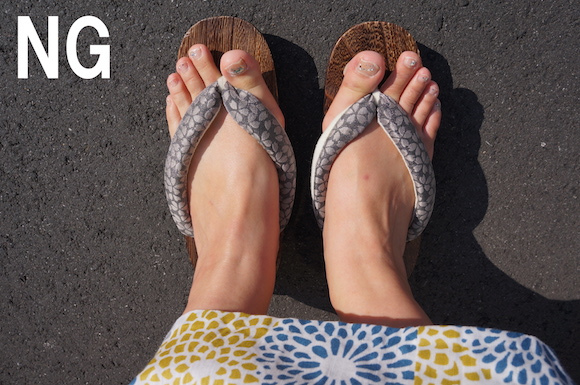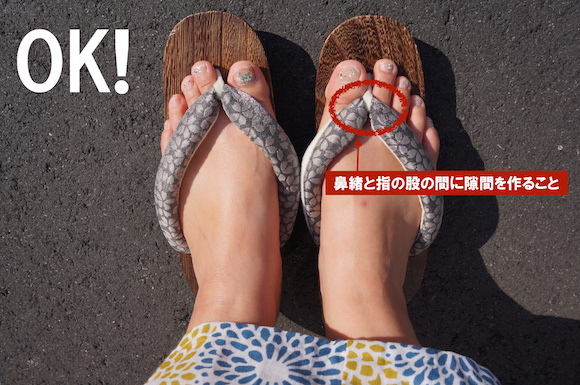
Do you know the real Japanese technique to wearing traditional footwear?
Summer in Japan is the season for festivals, which means it’s time to slip into your favourite yukata summer kimono, pull an obi sash around your waist, and slide your feet into a pair of traditional Japanese geta sandals. If it’s your first festival, you might also have a couple of Band-Aids with you, to cope with the blisters that come from wearing stiff wooden sandals on your feet. But there’s a way to avoid the pain entirely, and whether you’re a newbie or an experienced festival-goer, these tips that come direct from respected Japanese geta craftsmen will have you wanting to wear the shoes again and again!
If you’re used to wearing flip-flops, or thongs, as they’re known in Australia, you’ll probably wear geta in a similar way, with your feet pushed into the top of the shoe and the middle part of the strap wedged neatly between your toes. This, however, is no good (“NG”, as people say in Japan) when it comes to wearing traditional Japanese sandals.
Instead, you should push your feet back a bit and leave a gap between the strap and the connecting skin in between your toes. Ideally, the gap should be just wide enough for the tip of your little finger to fit through. The middle of the strap should also remain raised and not bent or twisted, in order to keep the material off the top of your foot. It might seem counterintuitive to wear the shoes this way, but doing so actually pushes your heel two to three centimetres (0.8 – 1.2 inches) off the back of the sandal, which helps with balance, making it easy to walk.
▼ Next time you try on a pair of geta, they should be a smaller size than you’re used to, so your heel hangs off the back while the middle strap is still within your toes.
To avoid pain at the back of the foot, you should step from toe to heel rather than heel to toe. If worn correctly, the front piece of wood under the shoe will appear more worn down than the back piece over time. To help, rather than “wearing” the shoes, people are advised to think of it as “pinching” them. While it sounds like the type of mystic, sage advice a student would receive from a master when learning a martial art, it does actually make sense and is much easier to do than it sounds. With the restrictiveness of the yukata naturally shortening your gait as you walk, it’s not difficult to pinch and “pick” the geta up with your toes as you shuffle along, sliding gracefully from toe to heel.
While the new walking style might feel strange at first, these tips and techniques used by geta wearers in Japan for centuries are designed to keep feet pain-free, leaving us with more energy to enjoy the fireworks and festival stalls. Try it the next time you’re out at a summer festival!
References: Tsujiya, Maruya Footwear Store
Photos © RocketNews24
[ Read in Japanese ]


 Kanye West receives flack for too-small Yeezy slides, calls it “The Japanese Way”
Kanye West receives flack for too-small Yeezy slides, calls it “The Japanese Way” Look stylish while working out on the daily with these crazy geta sandals
Look stylish while working out on the daily with these crazy geta sandals Cute cats come out to play as traditional Japanese geta sandals
Cute cats come out to play as traditional Japanese geta sandals Hanao Shoes: Dress like a modern-day geisha with new line of geta sneakers from Kyoto
Hanao Shoes: Dress like a modern-day geisha with new line of geta sneakers from Kyoto Adorable cat sandals from Japan welcome new arrivals to their feline footwear litter【Photos】
Adorable cat sandals from Japan welcome new arrivals to their feline footwear litter【Photos】 Starbucks Japan ready to get Year of the Horse started with adorable drinkware and plushies【Pics】
Starbucks Japan ready to get Year of the Horse started with adorable drinkware and plushies【Pics】 Hachiji juppun mae – A Japanese phrase that even Japanese people can’t agree on the meaning of
Hachiji juppun mae – A Japanese phrase that even Japanese people can’t agree on the meaning of Muscly Japanese men fill stock photo site with hilarious poses in unusual settings
Muscly Japanese men fill stock photo site with hilarious poses in unusual settings Nine tales of stunningly crazy customer complaints in from the Japanese service industry
Nine tales of stunningly crazy customer complaints in from the Japanese service industry McDonald’s Japan’s Samurai Mac series: which burger is the greatest warrior of all?
McDonald’s Japan’s Samurai Mac series: which burger is the greatest warrior of all? The unstaffed vegetable stand in Japan where you pick your produce yourself
The unstaffed vegetable stand in Japan where you pick your produce yourself Hayao Miyazaki’s The Wind Rises manga to be published in collected form for the first time
Hayao Miyazaki’s The Wind Rises manga to be published in collected form for the first time Impress your Japanese history professor with this T-shirt
Impress your Japanese history professor with this T-shirt Sumo Sanrio! Hello Kitty and pals team up with Japan Sumo Association for new merch【Pics】
Sumo Sanrio! Hello Kitty and pals team up with Japan Sumo Association for new merch【Pics】 “Ugly” South Korean woman goes from “Old Lady Face” to “Dream Girl” with help of cosmetic surgery
“Ugly” South Korean woman goes from “Old Lady Face” to “Dream Girl” with help of cosmetic surgery 7-Eleven Japan’s ramen-cooking robot whipped us up a bowl of noodles【Taste test】
7-Eleven Japan’s ramen-cooking robot whipped us up a bowl of noodles【Taste test】 Lacquerware supplier to emperor of Japan and Pokémon team up for new tableware
Lacquerware supplier to emperor of Japan and Pokémon team up for new tableware Cyberpunk anime meets traditional culture in Ghost in the Shell gold leaf Japanese changing screens
Cyberpunk anime meets traditional culture in Ghost in the Shell gold leaf Japanese changing screens 7 great places to see Mt. Fuji from without having to climb it
7 great places to see Mt. Fuji from without having to climb it Japan may add Japanese language proficiency, lifestyle classes to permanent foreign resident requirements
Japan may add Japanese language proficiency, lifestyle classes to permanent foreign resident requirements Hello Kitty Choco Egg figures are an adorable trip through three periods of Japanese pop culture【Pics】
Hello Kitty Choco Egg figures are an adorable trip through three periods of Japanese pop culture【Pics】 Japan’s otoshidama tradition of giving kids money at New Year’s gets a social welfare upgrade
Japan’s otoshidama tradition of giving kids money at New Year’s gets a social welfare upgrade Starbucks Japan releases new zodiac chilled cup drink for 2026
Starbucks Japan releases new zodiac chilled cup drink for 2026 Can a dirty butthole make you filthy rich in Japan? We’re starting a New Year’s lottery experiment
Can a dirty butthole make you filthy rich in Japan? We’re starting a New Year’s lottery experiment 7-Eleven Japan starts new temporary luggage storage service in over 300 branches
7-Eleven Japan starts new temporary luggage storage service in over 300 branches Disillusionment at Tsukiji’s tourist-target prices led us to a great ramen restaurant in Tokyo
Disillusionment at Tsukiji’s tourist-target prices led us to a great ramen restaurant in Tokyo Starbucks teams up with 166-year-old Kyoto doll maker for Year of the Horse decorations【Photos】
Starbucks teams up with 166-year-old Kyoto doll maker for Year of the Horse decorations【Photos】 Tokyo considering law requiring more trash cans following litter increase in heavily touristed area
Tokyo considering law requiring more trash cans following litter increase in heavily touristed area Tokyo’s Tsukiji sushi neighborhood asks tour groups to stay away for the rest of the month
Tokyo’s Tsukiji sushi neighborhood asks tour groups to stay away for the rest of the month Nintendo’s Kirby now delivering orders at Kura Sushi restaurants, but not in Japan
Nintendo’s Kirby now delivering orders at Kura Sushi restaurants, but not in Japan Tokyo event lets you travel back in time, for free, to celebrate 100 years since Showa era start
Tokyo event lets you travel back in time, for free, to celebrate 100 years since Showa era start Sanrio theme park in Japan announces plans to expand into a Sanrio resort
Sanrio theme park in Japan announces plans to expand into a Sanrio resort Stamina-destroying “Paralysis Noodles” are Tokyo’s newest over-the-top ramen innovation
Stamina-destroying “Paralysis Noodles” are Tokyo’s newest over-the-top ramen innovation Survey asks foreign tourists what bothered them in Japan, more than half gave same answer
Survey asks foreign tourists what bothered them in Japan, more than half gave same answer Japan’s human washing machines will go on sale to general public, demos to be held in Tokyo
Japan’s human washing machines will go on sale to general public, demos to be held in Tokyo Japan’s deadliest food claims more victims, but why do people keep eating it for New Year’s?
Japan’s deadliest food claims more victims, but why do people keep eating it for New Year’s? We deeply regret going into this tunnel on our walk in the mountains of Japan
We deeply regret going into this tunnel on our walk in the mountains of Japan Studio Ghibli releases Kodama forest spirits from Princess Mononoke to light up your home
Studio Ghibli releases Kodama forest spirits from Princess Mononoke to light up your home Major Japanese hotel chain says reservations via overseas booking sites may not be valid
Major Japanese hotel chain says reservations via overseas booking sites may not be valid Put sesame oil in your coffee? Japanese maker says it’s the best way to start your day【Taste test】
Put sesame oil in your coffee? Japanese maker says it’s the best way to start your day【Taste test】 No more using real katana for tourism activities, Japan’s National Police Agency says
No more using real katana for tourism activities, Japan’s National Police Agency says Starbucks Japan reveals new sakura drinkware collection, inspired by evening cherry blossoms
Starbucks Japan reveals new sakura drinkware collection, inspired by evening cherry blossoms Updated cherry blossom forecast shows extra-long sakura season for Japan this year
Updated cherry blossom forecast shows extra-long sakura season for Japan this year Traditional Japanese wooden footwear redesigned as indoor slippers to keep feet comfy and cool
Traditional Japanese wooden footwear redesigned as indoor slippers to keep feet comfy and cool Japanese Twitter can’t figure out how to wear these shoes, comes up with hilarious ideas
Japanese Twitter can’t figure out how to wear these shoes, comes up with hilarious ideas Beautiful, spongy soft modern Japanese sandals give you geta style without the traditional pain
Beautiful, spongy soft modern Japanese sandals give you geta style without the traditional pain Kung-fu shoe flipping tournament coming back to Yokohama Chinatown
Kung-fu shoe flipping tournament coming back to Yokohama Chinatown Weaving history, art and innovation together in a new range of Japanese yukata
Weaving history, art and innovation together in a new range of Japanese yukata Yukata summer kimono separates allow you to mix and match traditional outfits with everyday wear
Yukata summer kimono separates allow you to mix and match traditional outfits with everyday wear Wear Japan’s most iconic landmark on your shoes with this Adidas collaboration【Photos】
Wear Japan’s most iconic landmark on your shoes with this Adidas collaboration【Photos】 Japanese company creates a tiny sock for your big toe
Japanese company creates a tiny sock for your big toe One Piece teams up with Japanese fashion brand mis zapatos for funky, fashionable bags
One Piece teams up with Japanese fashion brand mis zapatos for funky, fashionable bags Sailor Shoes and Luna too! Sailor Moon pumps are the latest way for anime fans to get their kicks
Sailor Shoes and Luna too! Sailor Moon pumps are the latest way for anime fans to get their kicks Ahh…Feet Bliss! Affordable Custom Made Shoes from KiBERA Make You so Happy You’ll Want to Keep It a Secret!
Ahh…Feet Bliss! Affordable Custom Made Shoes from KiBERA Make You so Happy You’ll Want to Keep It a Secret! Socks with toes: The easy way to keep your feet smelling nice and looking fashionably quirky
Socks with toes: The easy way to keep your feet smelling nice and looking fashionably quirky Japanese upcycle brand makes ’80s obi sandals in collaboration with United Tokyo 【Photos】
Japanese upcycle brand makes ’80s obi sandals in collaboration with United Tokyo 【Photos】 [On Location at Somin Naked Festival] I Was So Cold I Actually Thought I Was Going To Die
[On Location at Somin Naked Festival] I Was So Cold I Actually Thought I Was Going To Die Tokyo’s cheapest shoe chain and 10 pairs of kicks that cost less than 10 bucks each
Tokyo’s cheapest shoe chain and 10 pairs of kicks that cost less than 10 bucks each Beautiful new Hatsune Miku shoes make you look like the virtual idol, look like her themselves too
Beautiful new Hatsune Miku shoes make you look like the virtual idol, look like her themselves too
Leave a Reply